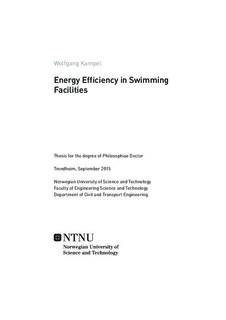| dc.contributor.author | Kampel, Wolfgang | |
| dc.date.accessioned | 2015-12-03T15:00:28Z | |
| dc.date.available | 2015-12-03T15:00:28Z | |
| dc.date.issued | 2015 | |
| dc.identifier.isbn | 978-82-326-0917-8 | |
| dc.identifier.issn | 1503-8181 | |
| dc.identifier.uri | http://hdl.handle.net/11250/2366793 | |
| dc.description.abstract | High and increasing energy use is a worldwide issue that has been reported and
documented in the literature. Various studies have been performed on renewable energy
and energy efficiency to counteract this trend. Although using renewable energy sources
reduces pollution, improvements in energy efficiency reduce total energy use and protect
the environment from further damage. In Europe, 40 % of the total energy use is linked
to buildings, making them a main objective concerning reductions in energy use. There
are many reports offering possibilities to increase energy efficiency in different building
types. However, compared with publications about residential or commercial buildings,
few publications have considered sports facilities. This building category contains a
variety of different facilities. Among sports facilities, two building types stand out due to
their excessive energy use: ice rinks and swimming facilities; this thesis addresses the
latter.
The goals of the thesis are as follows:
I Collect energy statistics from swimming facilities in European countries. An indepth
analysis of Norwegian facilities was conducted to compare them with similar
facilities in other countries and to define their potential for energy savings.
II Investigate different energy performance indicators (EPI). Few studies have
addressed the variety of different indicators for swimming facilities. In addition,
there is no consensus in the literature regarding which indicators are best to use.
III Characterise swimming facilities with the lowest energy use. Identify and describe
key figures and technologies.
A questionnaire was used to collect data, and answers from 43 Norwegian swimming
facilities were used in the analysis. All collected datasets were recalculated to match the
Oslo climate in 2010 for better comparison. A significant variation in final annual energy consumption (FAEC) was identified. The potential reduction of the FAEC in Norwegian
swimming facilities is estimated to be approximately 28 %.
Correlations between FAEC and the variables of interest were calculated. FAEC was
found to have the strongest correlation with water usage (WU), followed by the number
of visitors, the usable area (UA) and the water surface (WS). In reality, reliable values for
any of these variables are difficult to obtain except for the WS. The author recommends
using kWh/visitor as the unit for the EPI if reliable data is available, otherwise kWh/m²
WS can be used with certain limitations.
Additional data were collected to perform an in-depth analysis. Heat exchangers and heat
pumps are used to recover energy from the outgoing water and air in the facilities with
the lowest energy use. The energy is then used to warm incoming air, pool water and tap
water. The used technology is well known but the composition of the system is decisive.
However, even the best swimming facilities have potential for improvement. | nb_NO |
| dc.language.iso | eng | nb_NO |
| dc.publisher | NTNU | nb_NO |
| dc.relation.ispartofseries | Doctoral theses at NTNU;2015:130 | |
| dc.relation.haspart | Paper 1: Kampel, Wolfgang; Aas, Bjørn; Bruland, Amund. Energy-use in Norwegian swimming halls. Energy and Buildings 2013 ;Volum 59. s. 181-186 <a href="http://dx.doi.org/10.1016/j.enbuild.2012.11.011" target="_blank"> http://dx.doi.org/10.1016/j.enbuild.2012.11.011</a> | nb_NO |
| dc.relation.haspart | Paper 2: W. Kampel, S. Carlucci, B. Aas, A. Bruland, Energy performance indicators for a reliable benchmark of swimming facilities | nb_NO |
| dc.relation.haspart | Paper 3: Kampel, Wolfgang; Aas, Bjørn; Bruland, Amund. Characteristics of energy-efficient swimming facilities - A case study. Energy 2014 ;Volum 75. s. 508-512 <a href="http://dx.doi.org/10.1016/j.energy.2014.08.007" target="_blank"> http://dx.doi.org/10.1016/j.energy.2014.08.007</a> | nb_NO |
| dc.title | Energy Efficiency in Swimming Facilities | nb_NO |
| dc.type | Doctoral thesis | nb_NO |
| dc.subject.nsi | VDP::Technology: 500::Building technology: 530::Building, construction and transport technology: 532 | nb_NO |
